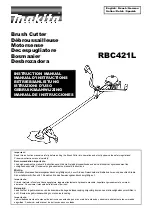
20
9 LIST OF DEVICE CONTROL INSTRUCTIONS
Device control instructions are used to determine the communication sequence between the PNC-900 and computer through
RS-232C interface and to tell the computer the current PNC-900 state. Among them, some device control instructions set the
output specifications of CAMM-GL III instructions.
Each device control instruction is organized with three letters: [ESC] , "." and one uppercase letter. Device control instruc-
tions are of two types: one with parameters and the other without parameters.
Parameters can be omitted. A semicolon ";" is used as a delimiter to separate parameters if they are input in succession. A ";"
without parameters means that parameters were omitted.
If parameters are omitted, the default value is set. For a device control instruction with para-meters, a terminator needs to be
input in order to signify the end of instructions. A colon ":" is used as the terminator which cannot be omitted.
Code
Meaning
0
Data remaining in buffer.
8
Buffer empty.
16
Data remaining in buffer. PNC-900
being paused (Pause On being displayed).
24
Buffer empty. PNC-900 being paused
(Pause On being displayed).
Instruction
Format
Parameter
Range ([ ] is default)
Explanation
Handshake Instructions
ESC .B
[ESC].B
None
Outputs the current remaining buffer capacity to the
Output Remaining
computer.
Buffer Capacity
ESC .M
[ESC].M<P1>;<P2>;
P1: Delay time
0—32767 (msec) [0 (msec)]
Sets handshake output specifications.
Set Handshake
<P3>;<P4>;<P5>;<P6>:
P2: Output trigger character
[0 (Sets nothing)]
Output
P3: Echo terminator
[0 (Sets nothing)]
Specifications (1)
P4: Output terminator
[13 ([CR])]
Note: When you specify some values to <P4> and
P5: Output terminator
[0 (Sets nothing)]
<P5>, always set 0 to <P6>. When you specify
P6: Output initiator
[0 (Sets nothing)]
some value to <P6>, always set 0 to <P5>.
ESC .N
[ESC].N<P1>;<P2>;
P1: Intercharacter delay
0—32767 (msec) [0 (msec)]
Sets an intercharacter delay, and also an Xoff
Set Handshake
<P3>; ••••• ;<P11>:
P2-P11
[All 0 (Sets nothing)]
character for performing the Xon/Xoff handshake.
Output
: Xoff character (for Xon/Xoff)
Specifications (2)
Immediate response character
(for ENQ/ACK)
ESC .H
[ESC].H<P1>;<P2>;
P1: The number of bytes for
0—15358 (byte) [80 (byte)]
When receiving the ENQ character set by <P2>,
Sets ENQ/ACK
<P3>; •••••••• ;<P12>:
data block
[0 (Sets nothing)]
compares the value set by <P1> and the remaining
Handshake Mode1
P2: ENQ character
[All 0 (Sets nothing)]
buffer capacity, and returns the ACK character to
P3-P12
the host computer when the remaining buffer
: ACK character (only when
capacity is larger. The [ESC].H with no parameter
<P2> is set)
performs a dummy handshake.
ESC .I
[ESC].I<P1>;<P2>;
P1: Limit of the remaining
0—15358 (byte) [80 (byte)]
Used for performing the Xon/Xoff handshake and
Set Xon/Xoff
<P3> ; •••••••• ;<P12>:
buffer capacity (for Xon/Xoff)
the ENQ/ACK handshake mode 2.
Handshake and
The number of data block bytes
The [ESC].I instruction with no parameter performs
ENQ/ACK
(for ENQ/ACK (mode2))
a dummy handshake. In a dummy handshake,
Handshake Mode2
P2: ENQ character
[0 (Sets nothing)]
always returns the ACK character to the host
(for ENQ/ACK (mode2))
computer, regardless of the remaining buffer
0 (for Xon/Xoff)
capacity, when receiving the ENQ character.
P3-P12
[All 0 (Sets nothing)]
: Xon character(for Xon/Xoff)
ACK character
(for ENQ/ACK (mode2))
ESC .@
[ESC].@ P1;P2:
P1: Ignored
Controls the DTR signal (No. 20 pin of RS-232C).
Controls DTR
P2: DTR signal control
0—255 [1]
An even number parameter (e.g. 0) always sets the
DTR signal to High without performing the
hardware handshake. An odd number parameter
(e.g. 1) performs the hardware handshake and
controls the DTR signal according to the remaining
buffer capacity.
Status Instructions
ESC .O
[ESC].O
None
Outputs the status codes of PNC-900 shown in
Outputs the Status
the table below.
of Buffer, Pause
Содержание PNC-900 Camm-1
Страница 1: ...ROLAND DG CORPORATION DESKTOP SIGN MAKER USER S MANUAL...
Страница 31: ...A3020195BE V4 1...






































